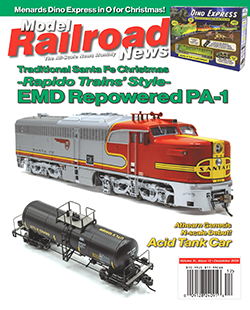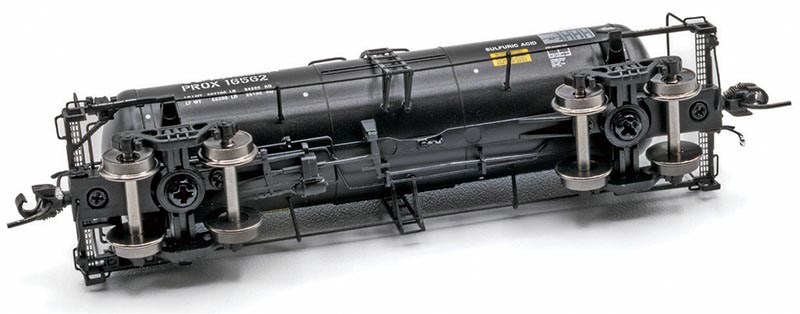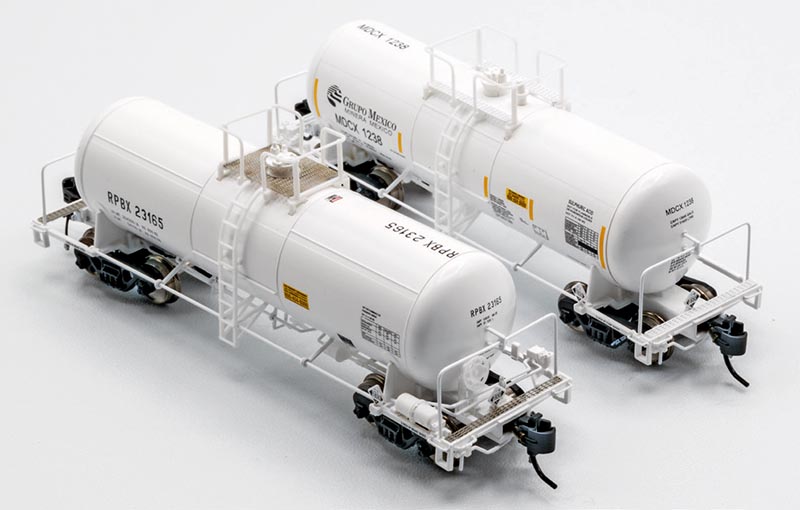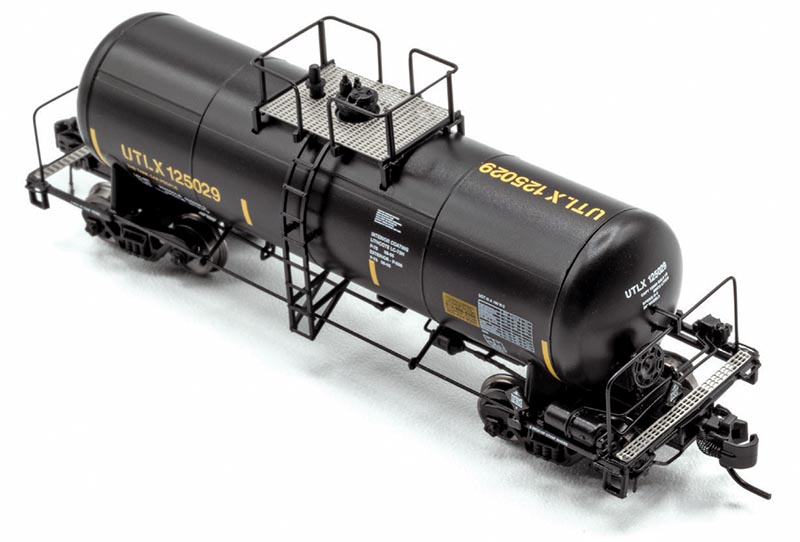 Reviews by Clem Harris, Justin Sobeck, and Shane T. Mason/photos by Tony Cook
Reviews by Clem Harris, Justin Sobeck, and Shane T. Mason/photos by Tony Cook
This all-new N-scale tank car replica was announced in May 2022, with a second production listed in January 2024, and Athearn recently delivered both batches of this absolutely amazing, perhaps the best looking and running 1:160 tank car on the market, during summer 2025. The offerings come fully assembled and packaged in clear jewel cases. Single tank cars and 3-pack sets are included in the production.
For those familiar with the manufacturer’s excellent Genesis 1:87 offerings, this new Union Tank Car 13,000-gallon acid tank car release looks like they shrink-rayed an HO car down to N scale! This small model is a big release for Athearn, marking the company’s first Genesis-branded effort for rolling stock in N scale. Model Railroad News’ regular N-scale modelers will provide their experience with this Athearn release.
Clem Harris
I spent some time reading up on tank cars and the various requirements that they have to safely transport a commodity. For this model and its prototype, my research was all about how tank cars are used to safely transport sulfuric acid.

ABOVE: This new Athearn Genesis N-scale acid tank car model includes see-through etched metal end platforms, body-mounted Type F double-shelf knuckle couplers, and 36-inch metal wheels.
The various standards for tank cars have gotten public attention in the last few years due to prolific derailments. Acid tank cars fall under the older DOT 111 standard that encompasses a minimum plate thickness of 7/16 inches, and can be made of various materials like aluminum or steel alloys, but carbon steel is most common. DOT 111 rated cars do not generally have shielding around the top or ends of the tank, thermal protection, and special fittings that have become standard on newer DOT 117 and DOT 117R cars. DOT 111 cars may or may not have a layer of insulation around them, and will slowly be phased out or upgraded to meet the new DOT 117R standard that took effect May 1, 2025.
Sulfuric acid has many uses, from drain cleaners in your home, to indus-trial cleaning agents in the manufactur-ing of steel, fertilizers, petroleum catalysts, the production of paper, and much more. The number that appears on the placard indicates the percentage of the sulfuric acid being transported, so first responders may deal with a spill or derailment accordingly (more about this on the model).
Athearn executed the reproduction of the various details of these cars correctly for the timeframes they represent. For me, the little details really make an N-scale product stand out. The printing on the car was crisp and clearly readable. One of the things that immediately caught my attention was the rectangular yellow notice showing Chemtrec’s phone numbers. The Procor car shows the era appropriate U.S. 1-800 number along with the separate phone number for reporting leaks and spills in Canada and Mexico found on older tank cars. Chemtrec’s reporting number meets the federal requirement to have an emergency response telephone number that is monitored 24/7 while hazardous commodities like sulfuric acid are being transported.

ABOVE: There is variety in the details across the road names included in Athearn’s first Genesis series N-scale freight car release. This fully assembled tank car replica is a fine addition to the 1:160 hobby market.
The models have diamond-shaped placards indicating the UN number (this is a unique four-digit code as-signed by the United Nations to iden-tify hazardous chemicals, materials, and articles for international transport and commerce. These numbers range from 0001 to 3500 and are crucial for proper handling, packaging, labeling, and emergency response for dangerous goods). This is a neat touch! The UN number for sulphuric acid that has a concentration of greater than 51 percent is 1830, which is denoted on the placards for both cars.
Additionally, the models incorporate vertical restraint-type couplers, more commonly known as shelf-style cou-plers. On the prototype, this prevents couplers from bypassing in derailments and potentially puncturing the ends of adjacent tank cars. This inclusion of the proper coupler demonstrates Athearn was paying close attention to the prototype. N-scale couplers are a bit of a pet peeve of mine, but these couplers were a positive experience, and worked well with other brands of couplers without being finicky or troublesome.
The details on these cars are absolutely amazing. See-through end walkways and manways on top of the cars further highlight the attention to detail these 1:160 reproductions were given. The trainline hoses on the ends of the cars cleared an appropriate height off the rail and did not cause any issues even on less than ideal trackwork.

The biggest question I have when I try out a new release like this, after examining the car for how well it matches with a known prototype, is how well the model performs. In a word, Athearn’s new acid tank car operated outstandingly. I’m not necessarily a “check the weight” kind of guy because on cars like this, there is nowhere to add additional weight if they are too light. With this in mind, I pushed and pulled these cars around the New Mexico Rail Runners N-scale layout for a couple of hours with no derailments or issues to report while operating them in a 22-car train. I placed the tank cars at various places in the consist to see if that would change this solid performing outcome, and Athearn’s Genesis acid tank car ran well no matter where it was placed in the train. Out of the box, the metal wheels were in gauge and the trucks rotated freely on their bolster.
I’m absolutely impressed with these models! With some light weathering, they’ll be right at home on your layout to serve your industries that may have a need for sulfuric acid…



